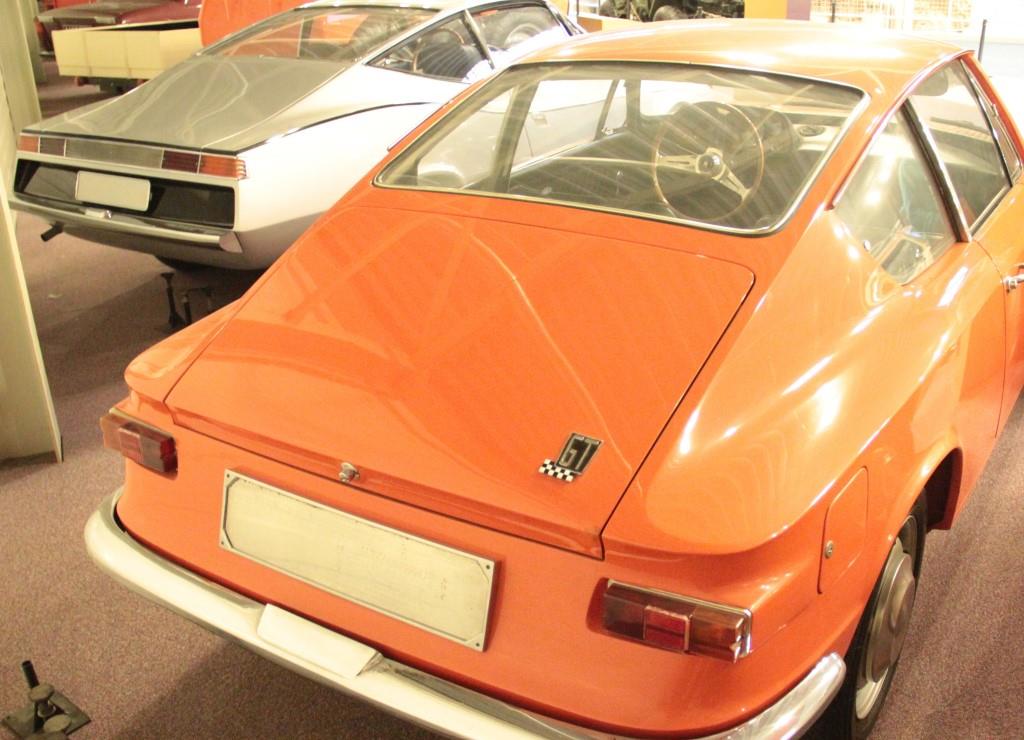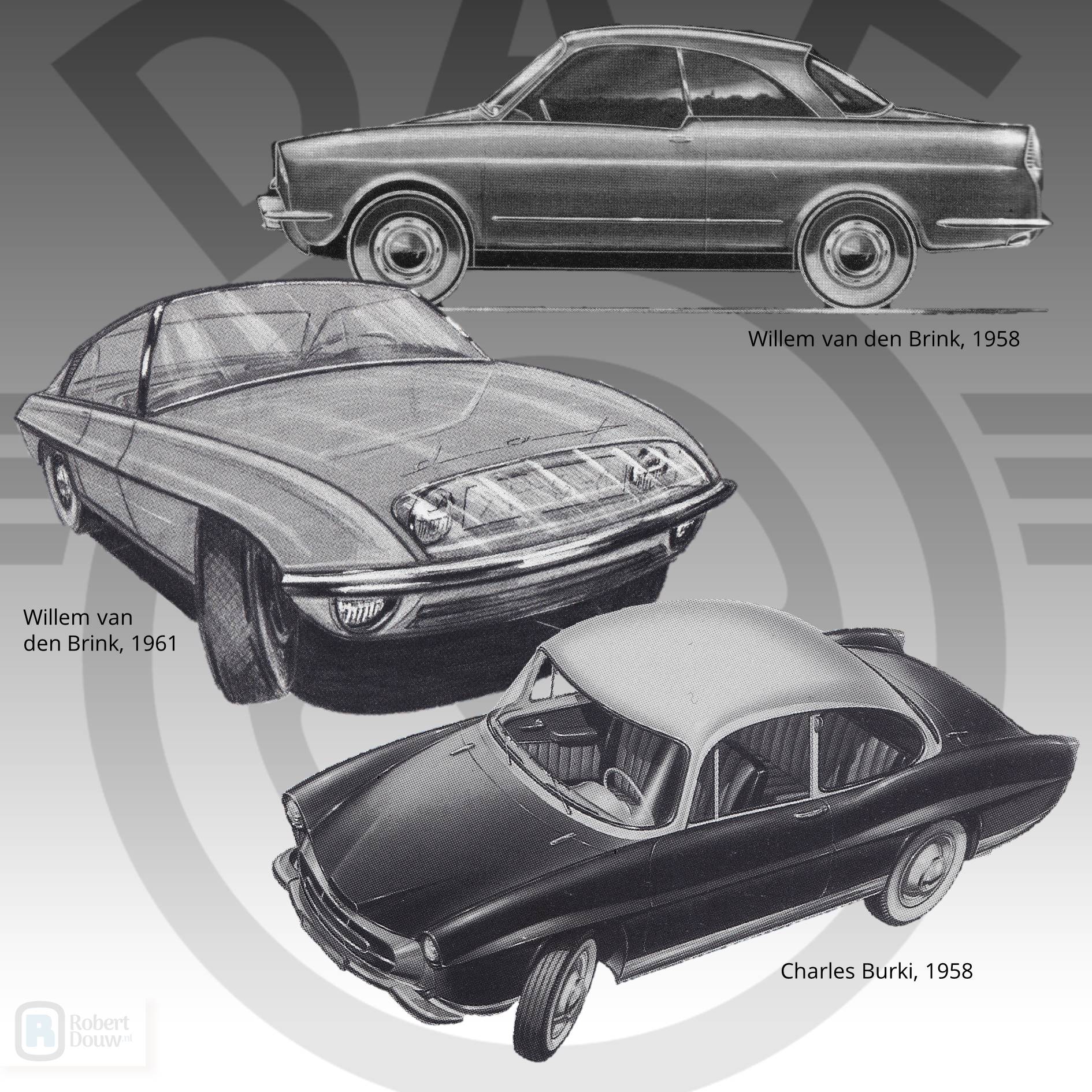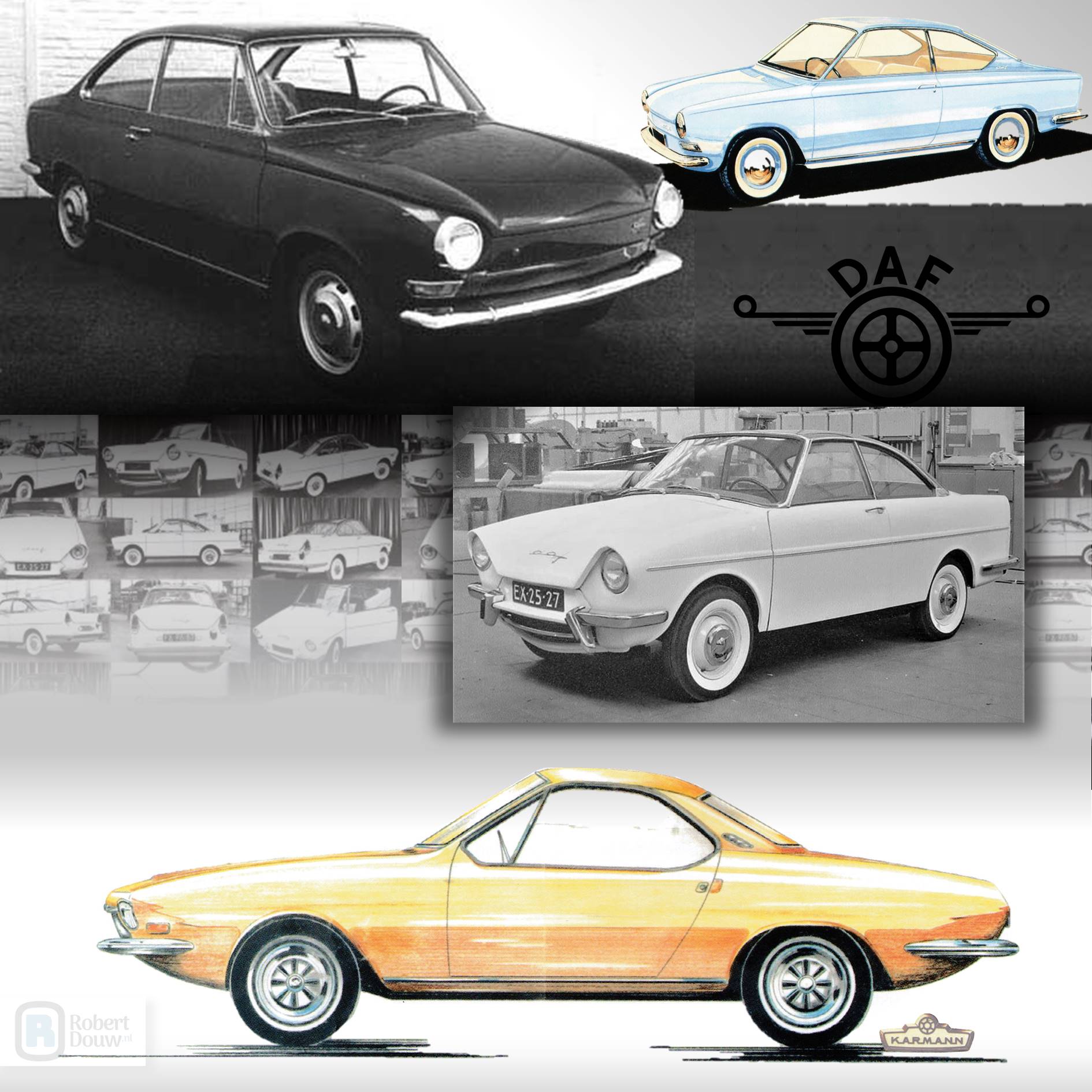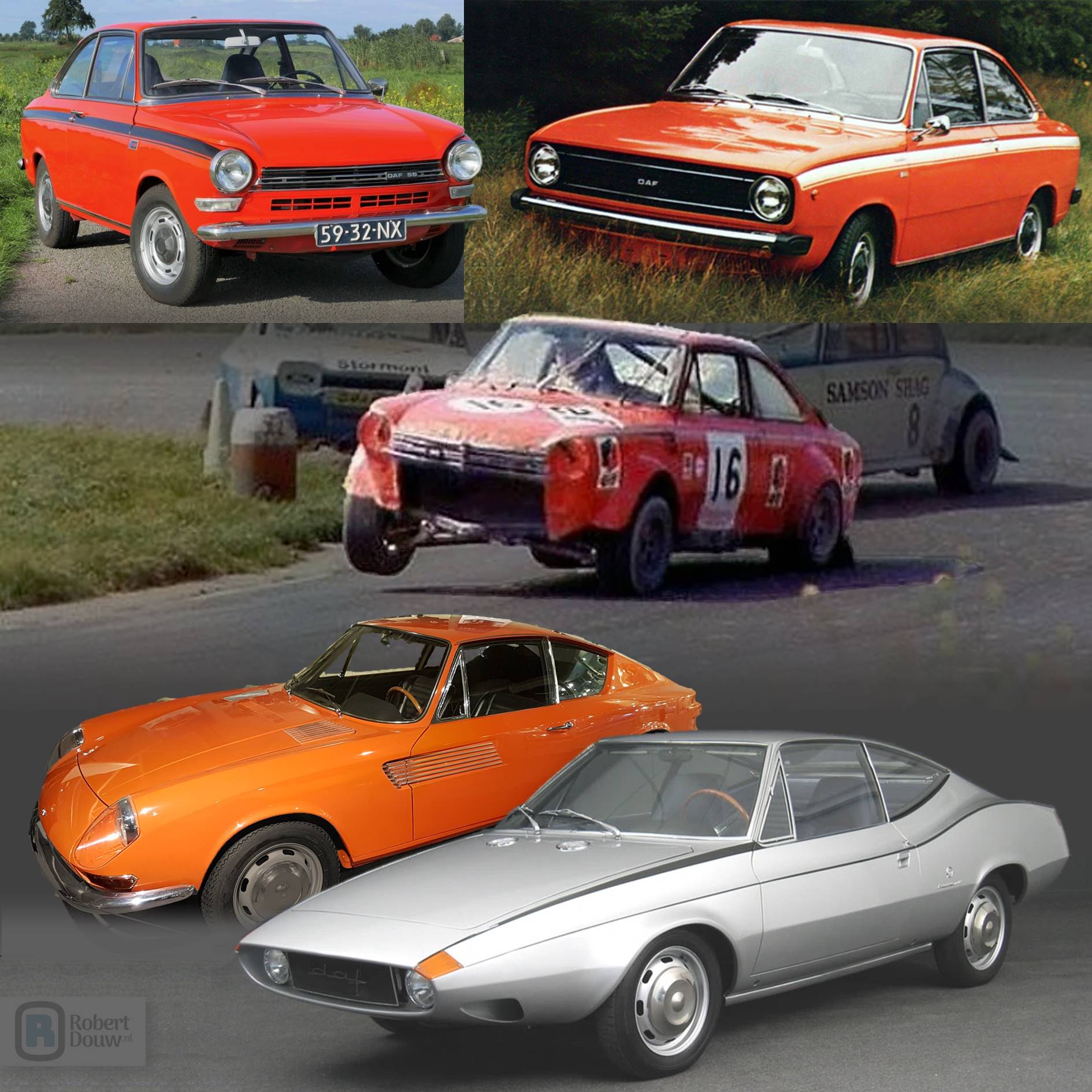MY CLASSICS
Daf coupés
Cars
| 09-01-2021
In addition to the production models of the 33, 44, 55 and 66, the DAF Museum also houses two very special designs by Michelotti: the 40 GT and Siluro. Both deserve and will get their own place in My classics. When I read up for writing those pieces, however, I came across so many beautiful designs for coupés that I think it would be a shame not to mention them. That's why I wrote today's special about the Daf coupés.

For a starting car manufacturer with the ideal of making an affordable car for the people, a practical model such as a sedan or station wagon is of course the obvious option. At the same time, as a lover of beautiful cars, you can hardly escape dreaming of a nice coupé. That dream also lived within Daf's ranks, already as early as 1958, so before the production of the 600 was even underway. Coupés of course come in all shapes and sizes, but the idea at Daf at the time was that it should rather be an elegant than a sporty model. Over the years, several proposals have been made, with some getting no further than a sketch and others getting stuck at the stage of running prototype – and everything in between. It took to 1968 before the dream became reality, in the form of the Daf 55 Coupé, which is indeed a coupé of the elegant kind. But sportier models were also considered.

It immediately starts well in 1958: Willem van den Brink, who had designed the 600, then made a sketch of what an elegant 600 Coupé could look like, and in the same year Charles Burki also designed a more elegant coachwork for the 600. These were, however, too expensive to produce. In addition, demand for the 600 was so high right from its show debut in 1958 that new machines had to be ordered to allow for greater production. I can imagine that adding a second body to that production would therefore not have been an option. In 1961 Van den Brink made a much more daring and aerodynamic design, with the headlights and license plate behind glass, much like the Citroën SM would get in 1970. Daf had the talent for an avant-garde design within their team, if the Van Doorne brothers had chosen to go for it. Unfortunately, it never got beyond a sketch.

In 1962, one Coupé was built on the basis of a 600 or 750 – my sources do not agree on this – which was allegedly used by Hub van Doorne's wife. This model is also known under the name Daf Furore coupé. A year later, in October 1963, Daf engineer Joan van der Brugghen was commissioned to look for an internationally renowned stylist in Turin. “When a painting is signed by Rembrandt, nobody dares to call it bad”, Hub van Doorne is said to have said. In the early years there had been some criticism of the designs of the Daf cars, and so the search for a master designer began. It was found in Giovanni Michelotti. In 1964 he made designs for the new Daf 44, including an elegant Coupé, of which prototypes were also built. However, it was decided to reserve that body style to the 55. This coupé was later, like the other 55's, upgraded to the 66. With the takeover by Volvo that Coupé was discontinued in 1975; Volvo only supplied the 66 as Sedan and Combi.

Within Daf, Martien van Doorne, son of Daf founder Hub, was particularly interested in a sports coupé. He was involved in sports activities with the Variomatic – many triumphant rallies were driven with various Daf cars and the Variomatic was also used successfully in Formula III – and from 1965 he was responsible for the development of new models at Daf, among other things. During one of his visits to Michelotti in Turin, the latter managed to get him excited about a sports coupé. This led to the full-size model of the 40 GT, which is on display at the Daf Museum and which I hope to tell more about soon. In 1967, while the 55 Coupé was being prepared for production, Martien van Doorne and Joan van der Brugghen flew to Matra in France and to Karmann in Germany. The idea was that one of the two companies would design a sports coupé on Daf technology and build it in small series. Matra declined the honour. Karmann did make a design based on the 44, but because the price would be too high and there were fears of internal competition with the own Coupé, it never came to series production for that sports coupé either. In 1968 Michelotti made another attempt with the futuristic Siluro, which he built on his own account based on the 55, but that too remained with one copy – on display at the Daf Museum and, if all goes well, later this year on this website!

The reason for this piece: the 40 GT and Siluro in the Daf Museum (2011, old line-up)
Dreaming of a coupéFor a starting car manufacturer with the ideal of making an affordable car for the people, a practical model such as a sedan or station wagon is of course the obvious option. At the same time, as a lover of beautiful cars, you can hardly escape dreaming of a nice coupé. That dream also lived within Daf's ranks, already as early as 1958, so before the production of the 600 was even underway. Coupés of course come in all shapes and sizes, but the idea at Daf at the time was that it should rather be an elegant than a sporty model. Over the years, several proposals have been made, with some getting no further than a sketch and others getting stuck at the stage of running prototype – and everything in between. It took to 1968 before the dream became reality, in the form of the Daf 55 Coupé, which is indeed a coupé of the elegant kind. But sportier models were also considered.

Early ideas for coupés by Willem van den Brink and Charles Burki
From stylish to futuristicIt immediately starts well in 1958: Willem van den Brink, who had designed the 600, then made a sketch of what an elegant 600 Coupé could look like, and in the same year Charles Burki also designed a more elegant coachwork for the 600. These were, however, too expensive to produce. In addition, demand for the 600 was so high right from its show debut in 1958 that new machines had to be ordered to allow for greater production. I can imagine that adding a second body to that production would therefore not have been an option. In 1961 Van den Brink made a much more daring and aerodynamic design, with the headlights and license plate behind glass, much like the Citroën SM would get in 1970. Daf had the talent for an avant-garde design within their team, if the Van Doorne brothers had chosen to go for it. Unfortunately, it never got beyond a sketch.

At the top the prototype of the 44 Coupé, behind it a drawing for that Michelotti model; in the middle the unique 'Furore'; at the bottom Karmann's design for a Daf sports coupé
Elegant variantsIn 1962, one Coupé was built on the basis of a 600 or 750 – my sources do not agree on this – which was allegedly used by Hub van Doorne's wife. This model is also known under the name Daf Furore coupé. A year later, in October 1963, Daf engineer Joan van der Brugghen was commissioned to look for an internationally renowned stylist in Turin. “When a painting is signed by Rembrandt, nobody dares to call it bad”, Hub van Doorne is said to have said. In the early years there had been some criticism of the designs of the Daf cars, and so the search for a master designer began. It was found in Giovanni Michelotti. In 1964 he made designs for the new Daf 44, including an elegant Coupé, of which prototypes were also built. However, it was decided to reserve that body style to the 55. This coupé was later, like the other 55's, upgraded to the 66. With the takeover by Volvo that Coupé was discontinued in 1975; Volvo only supplied the 66 as Sedan and Combi.

The production coupés 55 and 66; the 555; the 40 GT and the Siluro
Sports coupésWithin Daf, Martien van Doorne, son of Daf founder Hub, was particularly interested in a sports coupé. He was involved in sports activities with the Variomatic – many triumphant rallies were driven with various Daf cars and the Variomatic was also used successfully in Formula III – and from 1965 he was responsible for the development of new models at Daf, among other things. During one of his visits to Michelotti in Turin, the latter managed to get him excited about a sports coupé. This led to the full-size model of the 40 GT, which is on display at the Daf Museum and which I hope to tell more about soon. In 1967, while the 55 Coupé was being prepared for production, Martien van Doorne and Joan van der Brugghen flew to Matra in France and to Karmann in Germany. The idea was that one of the two companies would design a sports coupé on Daf technology and build it in small series. Matra declined the honour. Karmann did make a design based on the 44, but because the price would be too high and there were fears of internal competition with the own Coupé, it never came to series production for that sports coupé either. In 1968 Michelotti made another attempt with the futuristic Siluro, which he built on his own account based on the 55, but that too remained with one copy – on display at the Daf Museum and, if all goes well, later this year on this website!
MY CLASSICS
In the My classics section, I regularly add a model to my digital collection of classics. For that, I select cars whose design appeals to me or evokes memories. So nostalgia, and very subjective. Hence the section title: my classics.
Sources
- Brugghen, J. van der. (1988) Dertig jaren Nederlandse personenwagens; 1958-1988. Helmond: Volvo Car b.v.
- Zeeuw, J. de. (red.). (2005) Ongekend talent; De Daf personenwagen. Daf Club Nederland.
- Lange, J. de. (1997) Dafjes. Rijswijk: Uitgeverij Elmar B.V.
- carlogos.org
- wheelsage.org
- dafclub.de
- photobucket.com
- pinimg.com
- drivetribe.com
The photo in the Daf Museum is my own. I have composed the other images using the sources mentioned.
